December 4, 2014
On my last day at Bandon Dunes Golf Resort, I was scheduled to play two rounds at Bandon Trails. Every other day of the week had been fantastic weather but it, unfortunately, took a turn for the worse. It started raining around 4 a.m. and continued to rain through breakfast. I canceled two rounds in hopes I could get one round in with decent weather and moved my round from sunrise to around 10 a.m. Around 9 a.m., the weather cleared a bit and it looked like I might have made the right call. However, while stepping up to the first tee, the bottom dropped out of the sky and rains and wind akin to a monsoon ensued. The wind was blowing at a steady 20 mph and gusting to 45 mph. The rain was blowing sideways. This was going to be an interesting round.
 |
| Entrance sign for Bandon Trails. |
On the first tee, I met my playing partner from San Francisco, Jon Cheng, who had arrived ahead of his friends. He was a solo on the day and I was happy to share my round of rough weather with a kindred spirit. We teed off and the weather backed off just a bit. It would be on and off for the rest of the round, with the worst arriving around hole 15. It will start showing in the photos around hole nine when rain water started to seep into my camera and will be very apparent by hole 15 when the photos become poor. By hole 17, the camera no longer worked. Thankfully I save photos to a disc inserted into the camera.
 |
| The flag used on all the holes at Bandon Trails. |
Opened in 2005, Bandon Trails began atop a massive sand dune where it quickly opened into a sprawling meadow. The course is unique when compared to the other three courses on the property as it works higher into the coastal forest and returns to finish in the dunes. The course is enjoyable to walk and is a constant reminder of how the game was originally created among inland rolling dunes with dramatic ocean vistas.
Like the other courses on the Bandon property, there are five sets of tee boxes. From back to front, they are black, green, gold, blue, and orange. We opted to play from green on this day.
The first hole is a par 4 that plays to 356 yards. With the prevailing wind at your back, a driver is generally not be required. The fairway is much wider than it looks. The tee shot should favor the right side of the fairway, as most shots will feed back to the center. The second shot is slightly uphill through a saddle of sand dunes.
 |
| A look down the fairway from the 1st tee box. |
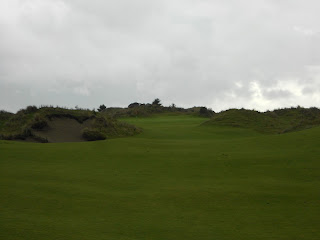 |
| A look into the first green from 100 yards out. |
The second hole is a par 3 that plays to 166 yards. Judging the impact of elevation change and wind will make club selection critical on this hole. The place to miss, although not visible from the tee, is short and left of the green. Par will be a struggle after any tee shot that misses right of this green.
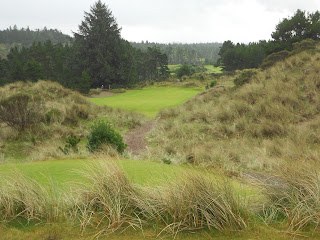 |
| A look onto the green from the 2nd tee box. |
The third hole is a par 5 that plays to 532 yards. You want to take aim at the bunker in the middle of the fairway as only the longest tee shots will bring it into play. Once on the fairway, factor the wind direction and carry distances to set up the ideal yardage for the third shot. The back of this green is deceptive and drops off abruptly.
 |
| A look down the fairway from the 3rd tee box. |
 |
| A look into the 3rd green from 75 yards out. |
 |
| A closer look at the 3rd green. |
The fourth hole is a par 4 that plays to 363 yards. A sand ridge runs across this fairway and challenges your tee shot. Distances to carry the ridge are shortest on the left, which will also gives the clearest view of the green. Balls clearing the ridge will shoot forward toward the green. If faced with a blind approach shot, the only safe miss is short and right of the green.
 |
| A look down the fairway from the 4th tee box. |
 |
| A look into the 4th green from 100 yards out. |
The fifth hole is a par 3 that plays to 124 yards. Don’t let the length of this hole give you a false sense of security, however. Club selection is critical, as the ball must end up on the same tier of the green as the hole to have a shot at a good score. This green is the most undulating on the course and a two putt is often well earned.
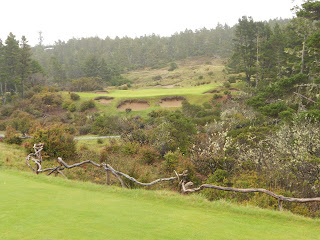 |
| A look into the green from the 5th tee box. |
 |
| A closer look at the 5th green. |
The sixth hole is a par 4 that plays to 359 yards. If you are an aggressive player, you may consider carrying the small fairway bunker off the tee. There is plenty of room left of the fairway bunker, but will offer a longer approach. Short and right of this green leaves the cautious player the best chance at par.
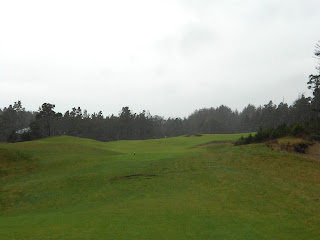 |
| A look down the fairway from the 6th tee box. |
 |
| A look into the 6th green from 125 yards out. |
The seventh hole is a par 4 that plays to 406 yards. The fairway is very generous. Don’t be afraid of the large fairway bunker on the left as the best approach to the green is from the left side of the fairway. A fairway wood or long iron second shot will likely be required to land this elevated green properly. The green is shallow on the left side and protected by a bunker behind.
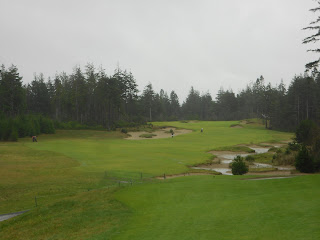 |
| A look down the fairway from the 7th tee box. |
 |
| A look into the 7th green from 150 yards out. |
The eighth hole is a short par 4 that plays to 299 yards. The reachable par four gives a great opportunity to weigh risk vs. reward. A well-struck drive may find the putting surface, but long putts on this undulating green are not easy. A lay-up off the tee to an ideal wedge yardage may be the better play.
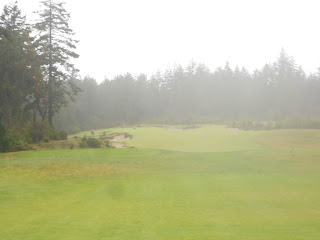 |
| A look down the fairway from the 8th tee box. |
 |
| A look into the 8th green from 100 yards out. |
The ninth hole is a par 5 that plays to 522 yards. Framed by dense coastal forest, the scale of this hole is deceiving. Make sure to check the yardage to the large fairway bunker on the right, as it may narrow the fairway in the landing area. From there, depending on the wind direction, you will have to decide whether to lay-up or go for it. In either case, there is much more space to receive a shot than it appears. At the green, you can comfortably miss long or left.
 |
| A look down the fairway from the 9th tee box. |
 |
| A look towards the 9th green from 150 yards out. |
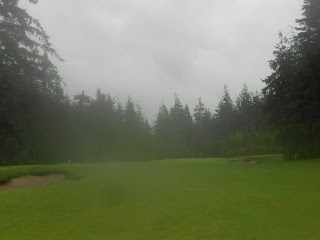 |
| A look into the 9th green from 100 yards out. |
The tenth hole is a par 4 that plays to 393 yards. This fairway is very generous. The open right side of this hole lures you in that direction, which will leave a longer approach crossing open sand to the green. You want to make sure to take enough club to hit it to the middle of the green. There is plenty of room to miss left.
 |
| A look down the fairway from the 10th tee box. |
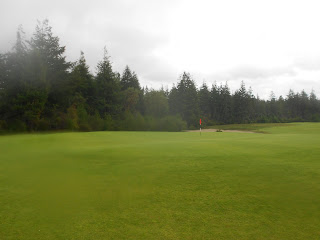 |
| A closer look at the 10th green. |
The eleventh hole is a par 4 that plays to 429 yards. This hole does not bend right as much as it first appears when standing on the tee box. A strong drive down the left side of this fairway provides the best angle into the green. Even the best tee shots will leave a lengthy approach to this green guarded by water on the right.
 |
| A look down the fairway from the 11th tee box. |
 |
| A look into the 11th tee box from 120 yards out. |
The twelfth hole is a long par 3 that plays to 235 yards. The green slopes will help funnel the ball toward the middle of the green. Subtle contours short and right will collect errant shots and help them toward the green.
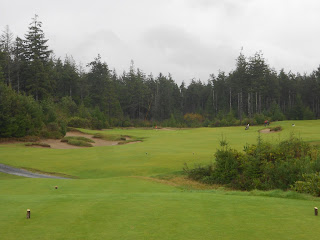 |
| A look towards the green from the 12th tee box. |
The thirteenth hole is a par 4 that plays to 374 yards. Accuracy is the focus on this hole. The ideal angle requires a tee shot toward the left fairway bunker. The dense native area right of the fairway comes quickly into play. An accurate approach to this elevated green is critical, as a deep bunker and dense foliage guard the right side.
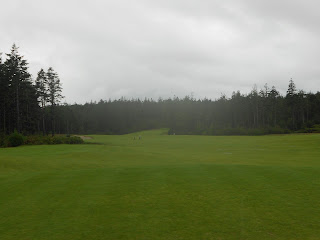 |
| A look down the fairway from the 13th tee box. |
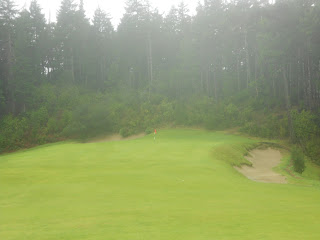 |
| A look into the 13th green from 75 yards out. |
After a tram ride to the top of a very large hill, you come to the fourteenth hole that is a par 4 and plays to 306 yards. The short par four can be played with a multitude of options. A driver may leave a shorter and slightly easier second shot. If you elect to play it safe from the tee, it is best to favor the left side of this fairway, as shots missed to the right will face a blind approach at the most shallow angle to the green. This hole’s greatest defense is its green – the smallest on the course.
 |
| A look down the fairway from the 14th tee box. |
 |
| A closer look at the 14th green from just off the back. |
The fifteenth hole is a par 4 that plays to 367 yards. Playing into the prevailing wind, this hole will require a strong drive to get as near to the cross bunker as possible. This will leave a short iron shot to an undulating and well protected green. A precise approach is a must, as you want to avoid leaving yourself above the hole, and a false front awaits any shots that come up short.
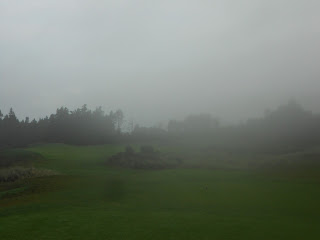 |
| A look down the fairway from the 15th tee box. |
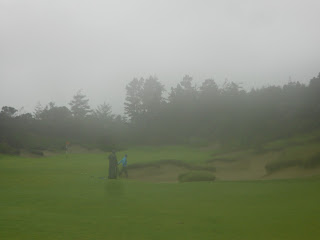 |
| A look into the 15th green from 120 yards out. |
The sixteenth hole is a par 5 that plays to 494 yards. Against the prevailing wind, this uphill par five will play longer than the yardage indicates. The tee shot is visually intimidating. The slopes on the right side funnels errant shots back to the fairway. On the approach, beware of a strategically placed bunker on the right, and factor your distance to it to ensure you finish comfortably short or beyond it.
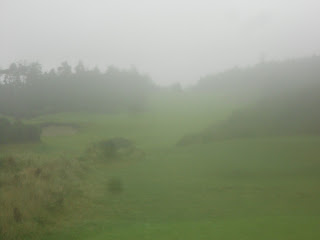 |
| A look down the fairway from the 16th tee box. |
The seventeenth hole is a par 3 that plays to 159 yards. It is framed by a menacing bunker right and two bunkers back and left. A false front forces you to fly the ball well onto the green. However, the green will feed balls into an open collection area long and right of the green, from which a par is manageable. A prevailing crosswind makes it all the more difficult to launch a high, soft shot on to this green.
 |
| A look onto the 17th green from the back side. |
At this point, my camera shut itself down due to the water that soaked the inside of it so I was unable to shoot any photos of the 18th hole.
The 18th is a par 4 that plays to 363 yards. The fairway is undulated and guarded by bunkers on the right and left sides. A well positioned tee shot down the left-center of the fairway will provide a shorter distance and the best angle in to the green. Yardage is key on the approach; take note of the prevailing wind and the elevated green as shots played past the false front will provide the best results.
Even with the rain and winds, the round was still enjoyable, especially with the company I had for the round. I hope to travel back to Bandon Dunes in 2015 or 2016 so I can provide better photos of this very fun course.

